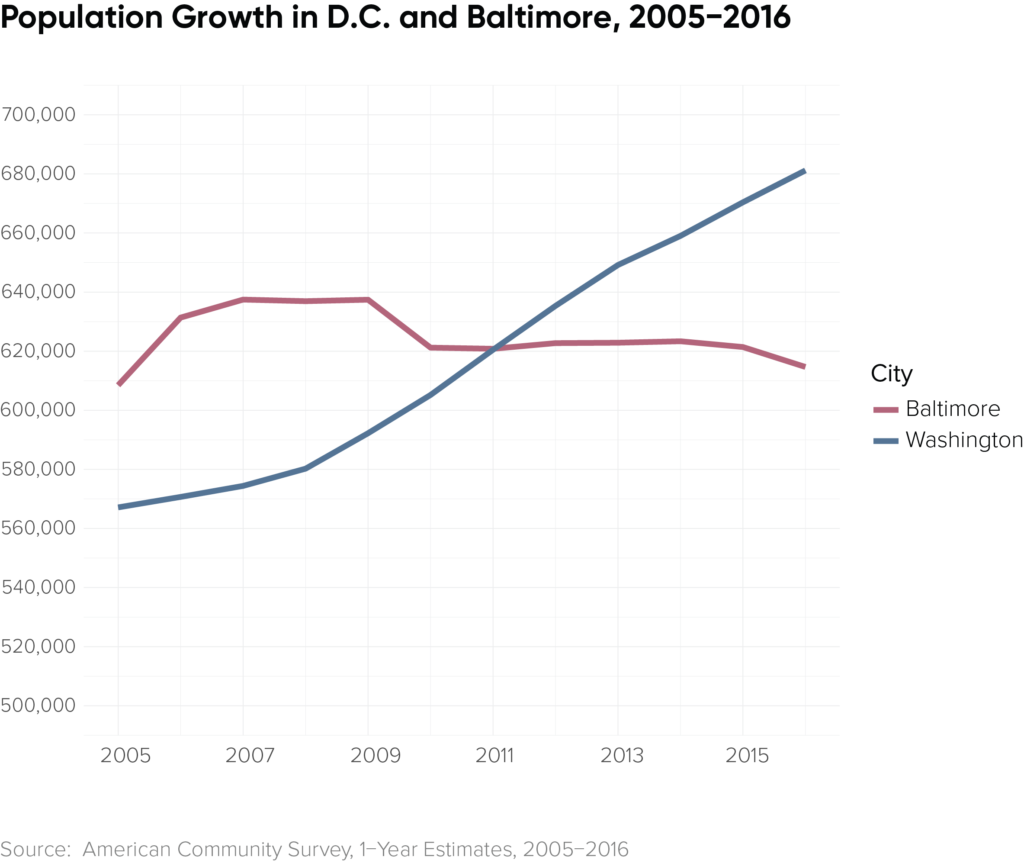D.C.’s population has grown significantly over the past decade, surpassing the population of Baltimore for the first time in history. Baltimore’s population, however, has stayed roughly the same during this same period of time, with a population decrease between 2015 and 2016.

As D.C.’s housing prices have continued to rise in the midst of this population boom, there have been more attempts to convince D.C. residents to move to Baltimore. Last year, an ad campaign by Live Baltimore pitched the city (and its relatively low home prices) to D.C. residents, claiming Baltimore offered D.C. residents the benefits of city living with the affordability of the suburbs. And for would-be commuters worried about the travel time, Maryland recently granted Elon Musk’s Boring Company permission to build 10.3 miles of a tunnel underneath the Maryland-owned portion of the Baltimore-Washington Parkway, part of Musk’s envisioned Hyperloop system that would run from D.C. to New York.
It’s true that home prices in D.C. are, on average, significantly higher than those in Baltimore— in June 2016, the median home sale price in D.C. was $561,775, compared to a median of $233,840 in Baltimore. Yet relatively few workers make the commute. According to the most recent data available, 4,937 Baltimore City residents commuted to the District of Columbia using 2009-2013 American Community Survey commute flow data. If Live Baltimore’s ad campaign has been successful—or if Elon Musk’s visions of Hyperloop transportation convince D.C. workers to make the move—it’s too soon to see the results using these data sources.
Where people cross state or county lines to get to work
In both the D.C. and Baltimore metro areas, most workers work within the metro area and state in which they live. Unsurprisingly, however, workers living in many of the counties bordering D.C. are more likely to cross state lines in their commute: only 58 percent of workers in Prince George’s County, 59 percent in Arlington County, and 63 percent in Alexandria work in their respective states of residence.
In most jurisdictions, most workers also work within the same county, but this varies across the region. Intuitively, workers are most likely to work outside of their county (or county-equivalent) of residence when they live in a jurisdiction that has a very small area—e.g., Falls Church, Fairfax City, or Manassas, where fewer than 25 percent of residents work in the county in which they live. Workers living in Arlington (33 percent) and Alexandria (28 percent) are also among those who are unlikely to work in their counties of residence.
Where do people cross county or state lines to get to work?
The percentage of workers working in the same county or state in which they live (click to toggle)
Source: American Community Survey, 2009-2013 5-year estimates
Commuter flows: Where workers commute to
So where exactly are workers commuting to? The interactive chart below breaks down commuter flows within the Baltimore-D.C. metro areas based on 2009-2013 ACS estimates, the most recent ACS data available. Each color corresponds to where workers live (on the left), while the ribbons, scaled to the relative size of commuter flows, show where they work (on the right).
Overall, 55 percent of workers who work in D.C. live in D.C.’s inner suburbs, 30 percent live in D.C. itself, and 4 percent live in Baltimore’s southern suburbs; only 1 percent live in Baltimore City, and 1 percent live in Baltimore county.
Looking at those who work in the broader D.C. metro area, those who live in counties between Baltimore and D.C. are also more likely to work in the D.C. metro area than those who live in Baltimore itself. While 25 percent of workers in Anne Arundel and Howard counties work in the D.C. metro area, only between 4 and 7 percent of workers in Baltimore City, Baltimore County, and Baltimore’s other suburban counties work in the D.C. area.
Residents of jurisdictions in the D.C. metro area are less likely to work in Baltimore than Baltimore metro area residents are to work in D.C – only 1 percent of D.C. residents work in the Baltimore metro area. More recent data will be necessary to determine whether Baltimore residents have started commuting to D.C. in larger numbers.
About the data
The analysis and charts in this piece were based on American Community Survey 2009-2013 5-Year estimates, available at the following links:
- Table 1. County to County Commuting Flows for the United States and Puerto Rico: 2009-2013
- Table B08007: Sex of Workers by Place of Work – State and County Level
American Community Survey data on commuting (journey to work) includes workers aged 16 and over.
Median home prices use June 2016 county sale price data from Zillow Data (available in the County zip files).
Simone Roy is a Research Associate at the D.C. Policy Center.
